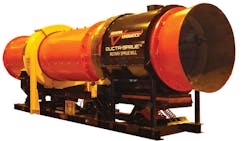Increasing quality standards are a fact of life for metalcasters, but they frequently face the problem of declining performance standards with their manufacturing operations: keeping production equipment performing at design standards is a problem in every section of a foundry, but possibly no process is as demanding on equipment as shakeout.
For example, in 2007 one metalcaster was using a rotary drum shakeout system in the way many foundries use such machines, to break up sprue and separate sand from metal, prior to returning the metallic content to the melting operation. After many demanding rotations, this system needed to be replaced so that the foundry could return to its performance standards.
The cast liner system in the drum had become worn out by excess wear, which caused the area between the liner body and the liner to become jammed with sprue and tramp metal. This disrupted the rotary process and accelerated further wear on the drum body.
Looking for a system that would be reliable and effective — but with a liner system that would be easier to maintain, and a drum body that would not need to patched frequently or replaced — the foundry’s maintenance and engineering team agreed with General Kinematics’ recommendation for a new DUCTA-SERIES™ rotary drum installation.
DUCTA-SERIES rotary drums are offered in two configurations: The XL models use a vibratory conveyor instead of the drum body to convey smaller metallics and media, meaning there is no need to replace the entire drum body due to wear. It also means no more plugging or jamming during the shakeout process (and no need to patch the damaged drum body.)
The SL models have the more standard method of using the inner shell of the drum to convey material back to the inlet sand discharge/media return wheel. There is no vibratory activity, and as a consequence the SL rotary foundry drums are easier to service. GK designs the system with bolt-in liner panels that are easier to replace and allow easy access to the area between the liner and the body, for quick cleaning and repair. Also, DUCTA-SERIES SL bodies are available as a retrofit for existing rotary drum drive structures.
The foundry placed an order for a new DUCTA-SPRUE® rotary sprue mill, which incorporated a heavy-duty bolt-in drum liner system, as well as a vibratory sand-return conveyor. The combination provides patented rotary technology along with vibratory material transfer equipment that results in a long-lasting, easy-to-maintain system for processing sprue, gates, and core butts. The foundry finds that the combination of these two technologies fully addressed its previous maintenance concerns.
According to General Kinematics’ director for foundry technologies, Claude Hutchens, selecting the right shakeout system depends on a foundry’s specific production requirements. For example, he noted, “the size of the Ducta-Sprue drum is determined by the type of iron being produced and the type of molding involved. This determines the diameter and length of the drum to increase sprue impact.”
Rotary shakeout systems endure a lot of impact. Whether a drum needs to be fully replaced, or whether a new liner is sufficient, is determined essentially by an evaluation of the condition of the drums’ outer body. “If the outer skin is in good condition, then a new skin liner and cartridge liner set can be installed in the old drum body,” Hutchens explained. “If the outer body is in poor condition, then the complete new body will need to be replaced.”
The foundry’s particular concerns also factored into the selection of its new rotary mill. The GK expert said the primary advantage of the Ducta-Drum is “the ease of customization and replacement for the liner sets.” Liners slide into the drum body easily, avoiding long periods of downtime.
The liner systems are fabricated from abrasion-resistant 450 Brinell steel. “This allows for quick construction of replacement parts,” Hutchens noted, “as well as customization of liner sets based on a foundry’s particular product type.”
This particular installation was effective and satisfactory for eight years, running the original liner set with only minor repairs until 2015. “The life expectancy for a liner set should be three to five years,” Hutchens offered, “depending upon usage and tonnage rates. We have seen customers extend the full liner set life by replacing partial liner sections in the high-wear zones.
“It is very possible to replace a partial set of liners in higher-wear zones,” he continued. “This is especially true when media is present, where higher wear is seen behind material retention dams.”
In 2015, the foundry’s maintenance team contacted General Kinematics to order their first set of replacement liners. The original liners were starting to show effects of wear, so the team decided — proactively — to replace them before they wore through. Once the order was placed, GK was able to develop, fabricate, and install the new liner in less than 12 weeks.
Acting proactively to maintain performance standards is essential for metalcasters who expect to uphold their own productivity standards, in order to meet customers’ quality standards.
About the Author
Robert Brooks
Content Director
Robert Brooks has been a business-to-business reporter, writer, editor, and columnist for more than 20 years, specializing in the primary metal and basic manufacturing industries. His work has covered a wide range of topics, including process technology, resource development, material selection, product design, workforce development, and industrial market strategies, among others.
